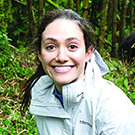An island of plants is improving the water quality and habitat in the Arboretum Waterway, but it didn't appear there naturally.
The floating pad, described in the above video, was launched near Putah Creek Lodge by Arboretum and Public Garden Learning by Leading Waterway Stewardship interns.
The Arboretum Waterway — the lowest place on campus — is the catch-all for the stormwater runoff as well as the campus’s recycled water. As a result, the water is rich in nitrate and phosphate levels, which creates the perfect growing conditions for algae and duckweed during our warm summers.
“In the past, we have had issues of decomposing algae blooms, which result in low dissolved oxygen and potential fish kills in the Waterway,” said Nina Suzuki, waterway steward. “Our floating island will demonstrate the effectiveness of green solutions to water pollution. Installing wetland plants is a sustainable, energy efficient method for removing nutrients and increasing dissolved oxygen, which will improve water quality.
Read more on the arboretum's website.

Facebook: Grad cap winners
UC Davis: That's a wrap on the 2018 Aggie Grad Cap Contest! Thank you to everyone who entered a design (269 entries) and voted on their favorites (over 35,000 votes)! [Click to see winners]
UC Davis expert explains different types of honey
Just because it's honey, its flavor can't always be described as "sweet." That's what Amina Harris, director of the Honey and Pollination Center at the Robert Mondavi Institute for Wine and Food Science, says about the numerous varieties of honey in the above video. The video is part of KQED's series "Taste This."

Twitter: Emmy Rossum is Gorilla Doctors ambassador
Gorilla Doctors: SPECIAL ANNOUNCEMENT: Gorilla Doctors is proud to reveal the appointment of actor @emmyrossum as Goodwill Ambassador for our organization! She will be dedicating her efforts toward raising awareness about the precarious state of these gorillas. [Click for link]